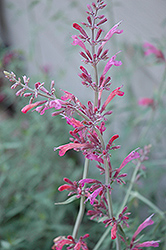Plant Height: 3 feet
Flower Height: 4 feet
Spread: 24 inches
Sunlight:
![]()
Hardiness Zone: 6a
Other Names: Anise Hyssop, Licorice Mint, Hummingbird Mint
Description:
This no-fail perennial provides long lasting color going into the fall; its tubular pink flowers with hints of orange attracts hummingbirds, clumping habit restrains it from spreading too fast
Ornamental Features
Desert Sunrise Hyssop features airy spikes of lightly-scented fuchsia tubular flowers with plum purple calyces rising above the foliage from mid summer to mid fall, which emerge from distinctive cherry red flower buds. The flowers are excellent for cutting. Its attractive fragrant narrow leaves remain grayish green in colour throughout the season.
Landscape Attributes
Desert Sunrise Hyssop is an open herbaceous perennial with an upright spreading habit of growth. Its relatively fine texture sets it apart from other garden plants with less refined foliage.
This is a relatively low maintenance plant, and is best cleaned up in early spring before it resumes active growth for the season. It is a good choice for attracting bees, butterflies and hummingbirds to your yard, but is not particularly attractive to deer who tend to leave it alone in favor of tastier treats. It has no significant negative characteristics.
Desert Sunrise Hyssop is recommended for the following landscape applications;
- Mass Planting
- General Garden Use
- Naturalizing And Woodland Gardens
- Herb Gardens
- Container Planting
Planting & Growing
Desert Sunrise Hyssop will grow to be about 3 feet tall at maturity extending to 4 feet tall with the flowers, with a spread of 24 inches. It grows at a fast rate, and under ideal conditions can be expected to live for approximately 6 years. As an herbaceous perennial, this plant will usually die back to the crown each winter, and will regrow from the base each spring. Be careful not to disturb the crown in late winter when it may not be readily seen!
This plant should only be grown in full sunlight. It prefers dry to average moisture levels with very well-drained soil, and will often die in standing water. It is considered to be drought-tolerant, and thus makes an ideal choice for a low-water garden or xeriscape application. It is not particular as to soil type, but has a definite preference for alkaline soils, and is able to handle environmental salt. It is somewhat tolerant of urban pollution. This particular variety is an interspecific hybrid. It can be propagated by division; however, as a cultivated variety, be aware that it may be subject to certain restrictions or prohibitions on propagation.
Desert Sunrise Hyssop is a fine choice for the garden, but it is also a good selection for planting in outdoor pots and containers. With its upright habit of growth, it is best suited for use as a 'thriller' in the 'spiller-thriller-filler' container combination; plant it near the center of the pot, surrounded by smaller plants and those that spill over the edges. It is even sizeable enough that it can be grown alone in a suitable container. Note that when growing plants in outdoor containers and baskets, they may require more frequent waterings than they would in the yard or garden.
Disclaimer - This resource is provided for informational purposes only and does NOT reflect current availability. Inventory varies seasonally, so we cannot guarantee that every plant will be in stock at all times - please contact your favourite GardenWorks location directly for current availability. It does not include our entire inventory of plants, so be sure to visit GardenWorks to see varieties that may not be represented on this list.

